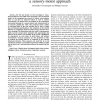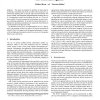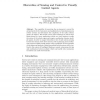34 search results - page 3 / 7 » Imitation Learning of an Intelligent Navigation System for M... |
ICRA
2003
IEEE
13 years 10 months ago
2003
IEEE
— As people move through their environments, they do not move randomly. Instead, they are often engaged in typical motion patterns, related to specific locations they might be i...
TSMC
2010
12 years 12 months ago
2010
Abstract--For the last decade, we have developed a visionbased architecture for mobile robot navigation. Our bio-inspired model of the navigation has proved to achieve sensory-moto...
ECAI
2000
Springer
13 years 9 months ago
2000
Springer
This paper investigates the problem of improving the performance of general state-of-the-art robot control systems by autonomously adapting them to specific tasks and environments...
AAAI
1992
13 years 6 months ago
1992
This paper describes a series of experiments that were performed on the Rocky III robot.1 Rocky III is a small autonomous rover capable of navigating through rough outdoor terrain...
SOFSEM
2000
Springer
13 years 8 months ago
2000
Springer
The capability of perceiving the environment is crucial for advancing the level of autonomy and sophistication of (semi)autonomous robotic systems and determines the complexity of ...



